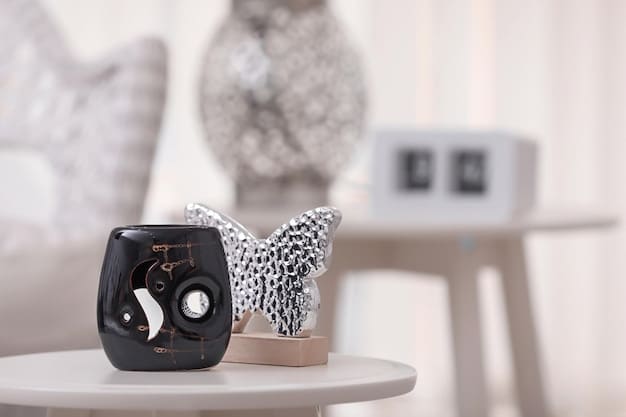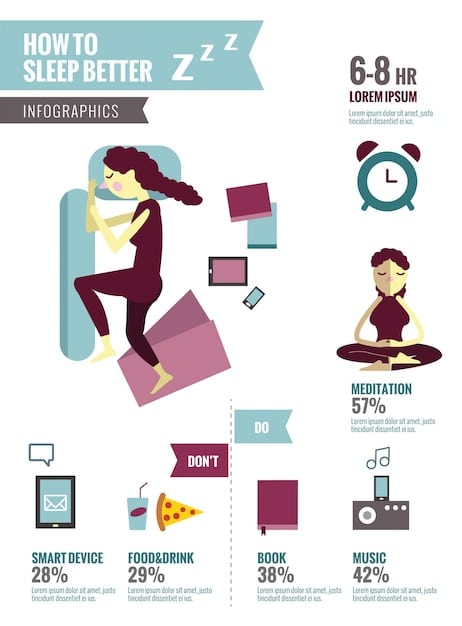White Noise for Home Office: Boost Concentration with Sound Science

White noise leverages principles of sound science to mask distracting noises, creating an auditory environment that can enhance concentration and productivity in your home office.
Is your home office a constant battle against distractions? Discover how the science of sound, specifically using white noise to improve concentration in your home office, can transform your workspace into a haven of focus and productivity.
Understanding the Science of Sound and Concentration
To understand how white noise can improve concentration, it’s essential to first grasp the basic principles of how sound affects our brains. The sounds around us constantly vie for our attention, some more successfully than others. By understanding the science behind sound, we can begin to strategically use it to our advantage.
How Sound Impacts the Brain
Sound waves travel to our ears, where they are converted into electrical signals that are sent to the brain. These signals are then processed in various areas of the brain, including the auditory cortex, which is responsible for interpreting sound.
The Role of the Auditory Cortex
The auditory cortex isn’t just about hearing; it’s also connected to other areas of the brain that are involved in attention, memory, and emotion. This means that sounds can have a significant impact on our cognitive functions, influencing our ability to concentrate and focus.

Here are some key ways sound can affect the brain and concentration:
- Distraction: Loud or sudden noises can easily disrupt concentration, pulling attention away from the task at hand.
- Stress: Unpleasant or jarring sounds can trigger the release of stress hormones, making it harder to focus.
- Cognitive Load: A noisy environment increases cognitive load as the brain works harder to filter out irrelevant sounds, reducing mental resources available for the primary task.
Understanding these impacts lays the groundwork for understanding how white noise can be beneficial. By managing the types of sounds we are exposed to, we can create a more conducive environment for concentration.
What is White Noise and How Does It Work?
Now that we understand the basics of sound and the brain, let’s dive into what white noise is and how it works to improve concentration. White noise is a specific type of sound that can effectively mask distracting noises and create a more uniform auditory landscape.
Defining White Noise
White noise is a consistent, static-like sound that contains all frequencies at equal intensities. This means that it covers the entire spectrum of audible frequencies, from low bass tones to high-pitched trebles. Think of it as the auditory equivalent of white light, which contains all colors of the spectrum.
The Masking Effect
The primary way white noise works is through a phenomenon known as masking. It covers up other, more distracting sounds by creating a constant, uniform soundscape. This can be particularly helpful in environments where there are intermittent or unpredictable noises.
Here’s why the masking effect is so effective:
- Reduces Contrast: By creating a consistent background sound, white noise reduces the contrast between ambient noises and sudden disruptions.
- Minimizes Startle Response: Sudden noises often trigger a startle response, causing a temporary dip in concentration. White noise can help minimize this effect.
- Auditory Habituation: Over time, the brain becomes accustomed to the white noise and filters it out, allowing for better focus on the task at hand.
While white noise is commonly used, it’s also important to consider other colors of noise, such as pink noise and brown noise, which have slightly different frequency distributions and effects.
The Benefits of White Noise in a Home Office Setting
The benefits of using white noise in a home office extend beyond just masking distracting noises. It can have a positive impact on several aspects of cognitive function and overall well-being.
Improved Focus and Concentration
One of the most significant benefits of white noise is its ability to improve focus and concentration. By creating a more uniform auditory environment, it allows the brain to allocate more resources to the task at hand and less to filtering out distracting sounds.
Enhanced Productivity
With improved focus comes enhanced productivity. When you’re less distracted by ambient noises, you can work more efficiently and accomplish more in the same amount of time. This can be especially valuable in a home office setting where distractions are often plentiful.

Other benefits include:
- Reduced Stress: Consistent background noise can be soothing, reducing feelings of stress and anxiety.
- Better Sleep: If your home office is also your bedroom, white noise can help improve sleep quality by masking nighttime noises.
- Increased Comfort: A quieter, more controlled auditory environment can simply make your workspace more comfortable and inviting.
The cumulative effect of these benefits can be a significant improvement in overall work experience, making a home office a more pleasant and productive place to be.
Different Types of White Noise and Their Uses
While white noise is the most well-known type of sound masking, it’s not the only option. Different “colors” of noise have varying frequency distributions and can be more suitable for certain situations.
White Noise vs. Pink Noise vs. Brown Noise
White noise, as we’ve discussed, contains all frequencies at equal intensities. Pink noise, on the other hand, has a slightly different distribution, with lower frequencies being more prominent. Brown noise (also known as red noise) has even more emphasis on the lower frequencies.
Which Type is Right for You?
Choosing the right type of noise depends on personal preference and the specific environment. Some people find white noise too harsh and prefer the gentler sound of pink noise or brown noise. Experimenting with different options can help you find the one that works best for you.
Here’s a quick breakdown of the differences:
- White Noise: Best for masking a wide range of sounds and creating a uniform auditory environment.
- Pink Noise: Often preferred for its softer, more natural sound. Can be good for sleep and relaxation.
- Brown Noise: Deepest and most bass-heavy of the three. Some find it calming and grounding.
In addition to these, there are also other options like nature sounds (e.g., rain, ocean waves), fans, and even specially designed soundscapes that can provide a similar masking effect.
How to Implement White Noise in Your Home Office
Implementing white noise in your home office is relatively simple and can be done using a variety of devices and methods. Here are some practical steps to get started.
Choosing the Right Device
There are several types of devices you can use to generate white noise. These include dedicated white noise machines, smartphone apps, and even online sound generators.
Setting Up Your Sound Environment
Once you’ve chosen your device, the next step is to set up your sound environment. This involves finding the right volume level and placement for your white noise source.
Consider these tips:
- Volume Level: Start with a low volume and gradually increase it until it effectively masks distracting noises without being obtrusive.
- Placement: Position the white noise source away from your direct line of sight to minimize visual distraction.
- Experimentation: Try different types of white noise and volume levels to find what works best for you.
Remember, the goal is to create a consistent, unobtrusive background sound that helps you focus. It may take some trial and error to find the perfect balance.
Troubleshooting Common Issues with White Noise Use
While white noise can be incredibly beneficial, some people may experience issues or find it difficult to adjust to. Here are some common problems and how to troubleshoot them.
Addressing Potential Drawbacks
One potential drawback of white noise is that it can become monotonous or irritating for some people. If you find yourself feeling this way, try switching to a different type of noise or taking breaks from the sound.
The Importance of Breaks
It’s important to take regular breaks from white noise to avoid auditory fatigue. Step away from your workspace for a few minutes every hour or two to give your ears a rest.
Consider these points:
- Vary the Sound: Alternate between white noise, pink noise, and nature sounds to keep things interesting.
- Adjust the Volume: Periodically adjust the volume to prevent your brain from becoming too accustomed to the sound.
- Listen to Your Body: If you start feeling uncomfortable or irritated, take a break from the sound immediately.
By being mindful of these potential issues and taking steps to address them, you can maximize the benefits of white noise while minimizing any negative side effects.
| Key Point | Brief Description |
|---|---|
| 🔊 Masking Effect | White noise covers distracting sounds, improving focus. |
| 🧠 Brain Impact | Reduces cognitive load by minimizing auditory distractions. |
| 😴 Sleep Quality | Can improve sleep by masking nighttime noises. |
| 🌈 Noise Types | Experiment with white, pink, and brown noise for optimal focus. |
Frequently Asked Questions
▼
White noise is a consistent sound that includes all frequencies at the same intensity. This creates a uniform background noise that can effectively mask other distracting sounds, helping to improve focus and concentration.
▼
White noise helps by masking distracting sounds that can pull your attention away from the task at hand. It reduces the contrast between ambient noises, minimizing the startle response and making it easier to maintain focus.
▼
Yes, there are different “colors” of noise, including pink noise and brown noise. Pink noise has a slightly lower frequency distribution, while brown noise is even more bass-heavy. Each type can have varying effects on different people.
▼
While generally safe, white noise can become monotonous or irritating for some people. Taking regular breaks and varying the type of sound can help prevent these negative effects. Always listen to your body and adjust as needed.
▼
You can use dedicated white noise machines, smartphone apps, or online sound generators. Experiment with different volume levels and placements to find what works best for you. The goal is to create a consistent, unobtrusive background sound.
Conclusion
Incorporating white noise into your home office can be a game-changer for enhancing focus and productivity. By understanding the science of sound and experimenting with different types of noise, you can create an auditory environment that supports your work and well-being.





